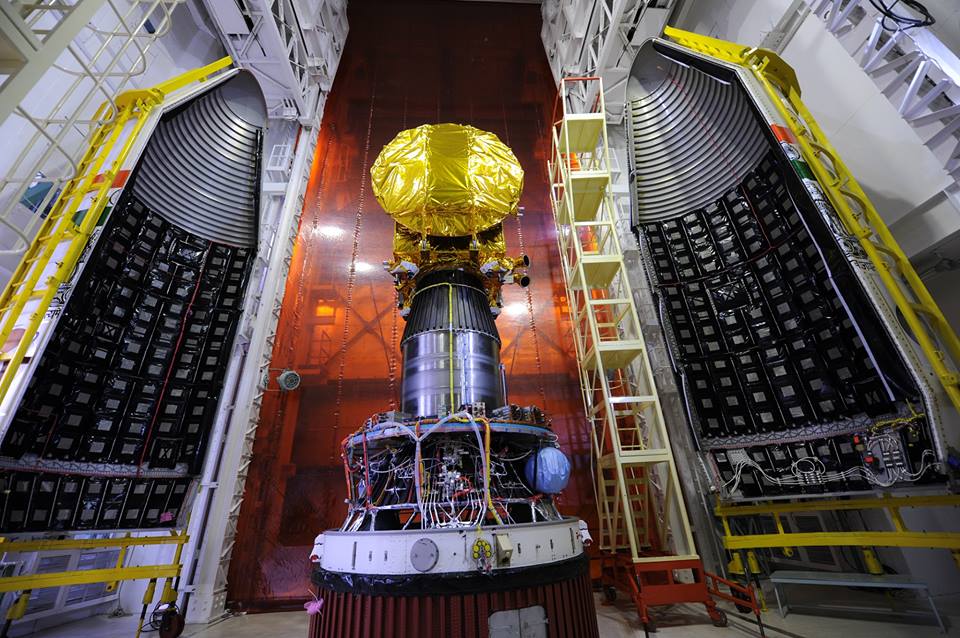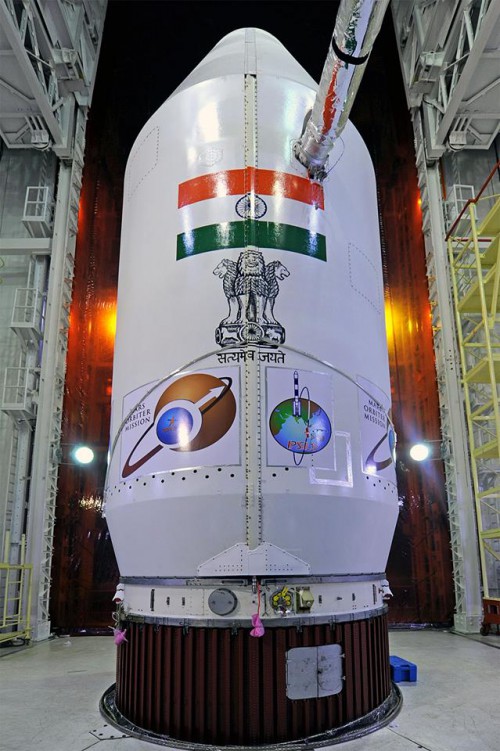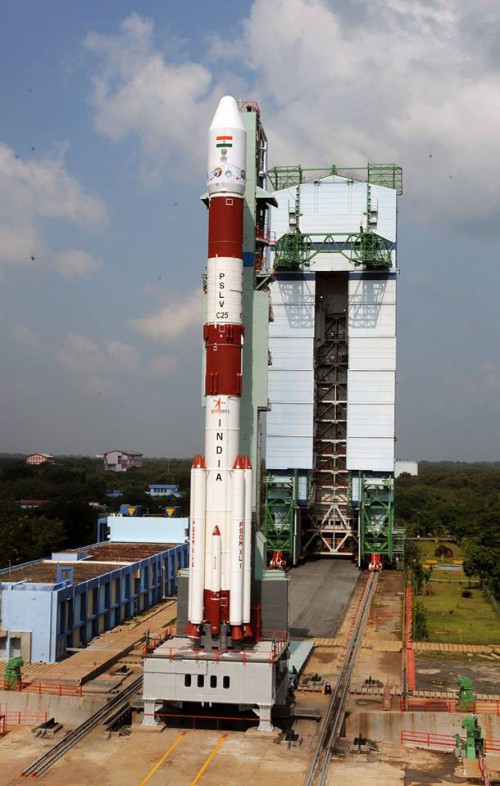
As the final days tick away before its first mission to Mars, the Indian Space Research Organisation (ISRO) conducted a launch rehearsal yesterday (Thursday, 31 October), preparatory to the official beginning of the countdown on Sunday, 3 November, and a planned liftoff on Tuesday, 5 November. In a characteristically brief update on its website, the Bangalore-headquartered ISRO announced that its “Launch Rehearsal commenced at 6:08 a.m. IST” Thursday (8:38 p.m. EDT Wednesday) and added simply “Vehicle systems powered and health is normal.” The rehearsal concluded Thursday afternoon. According to FirstPost India, the countdown will produce a liftoff at 2:38 p.m. IST (4:08 a.m. EST) Tuesday, within an exceptionally tight “window” of just five minutes. The flight has been postponed by several days, due to poor weather conditions in the Pacific Ocean which delayed the arrival of two critical ISRO tracking ships in Fiji.
Known as the Mars Orbiter Mission (MOM)—but also nicknamed “Mangalyaan” (Hindi for “Mars Craft”)—this is a highly ambitious, and almost unlikely, expedition for the world’s second most populous nation. It is described as “a technology demonstration project” and its primary task is to prove that India can design, plan, manage, launch, and operate a deep-space mission across the enormous gulf to reach the Red Planet. It only received formal approval and a $41 million financial injection from the Indian government in August 2012. With anticipated costs as high as $100 million, the mission has unsurprisingly provoked debate from critics who feel that India could better spend the money on more down-to-earth issues, such as power failures, droughts, and the aftermath of the recent Cyclone Phailin. Still, one government official retorted in a BBC interview that “if we don’t dare dream big, it would just leave us as hewers of wood and drawers of water,” noting that “India is today too big to be just living on the fringes of high technology.”

Equipped with five scientific instruments—the Methane Sensor for Mars (MSM), Mars Colour Camera (MCC), Mars Exospheric Neutral Composition Analyser (MENCA), Thermal Infrared Spectrometer (TIR), and Lyman-Alpha Photometer (LAP)—the MOM/Mangalyaan spacecraft is scheduled to arrive at the Red Planet in September 2014. Its mission is dedicated to developing a better understanding of the morphology, topography, and mineralogy of the Martian surface, together with the dynamics of its thin upper atmosphere, the influence of solar wind and radiation, and the nature of its large moon, Phobos.
With a month-long “window” to reach Mars, extending from 21 October until 19 November, ISRO initially settled on 28 October as its preferred opening launch date. The spacecraft and its four-stage Polar Satellite Launch Vehicle (PSLV)-XL were fueled and integrated at the Satish Dhawan Space Centre on the barrier island of Sriharikota, within India’s southern province of Andhra Pradesh, in mid-October and the Launch Readiness Board convened to formally announce the launch date. However, the Deccan Chronicle explained that the Board “met inconclusively” and it was not until 22 October that a revised decision was made to launch on 5 November.
The postponement is due to a number of issues, not least of which has been poor weather conditions in the South Pacific Ocean, which delayed the arrival of Marine Vessel (MV) SCI Nalanda—ISRO’s main tracking ship to monitor the PSLV-XL’s ascent—in the Fijian port of Suva for tests. Both the Nalanda and her sister vessel, the SCI Yamuna, both having checked out their systems in Fiji, were later despatched to their operational tracking locations. According to the Fiji Times, the Nalanda “is required to be located around 19 degrees South latitude and 160 degrees West longitude,” whilst the Yamuna will operate at 20 degrees South latitude and 130 degrees West longitude. When they are both on-station, the two ships will be about 3,450 miles (5,550 km) apart and more than 10,350 miles (16,650 km) from India. Both ships are provided by the Shipping Corporation of India and will be tasked with tracking the firing of the PSLV-XL rocket’s fourth stage and the insertion of the MOM/Mangalyaan payload into space.
With the successful conclusion of yesterday’s launch rehearsal, ISRO Chairman Dr. K. Radhakrishnan told FirstPost India that a Mission Readiness Review will take place today (Friday, 1 November) and the 56-hour countdown will commence at 6:08 a.m. IST Sunday (8:38 p.m. EDT Saturday). Liftoff of the PSLV rocket—flying in its uprated “XL” configuration, which undertook its inaugural mission back in October 2008—from Sriharikota is targeted for 2:38 p.m. IST (4:08 a.m. EST) Tuesday, 5 November. The vehicle will be powered for the first portion of its flight by a single first-stage engine and six strap-on boosters, all of which utilize a solid fuel of hydroxyl-terminated polybutadiene. Although the boosters will burn for just 44 seconds, the first stage will continue to drive the PSLV-XL uphill for the first 4.5 minutes of ascent.

The second stage and its single Vikas liquid-fueled engine will take over for 2.5 minutes, followed by the solid-fueled third stage for another 83 seconds and lastly the twin liquid-fueled motors of the fourth stage for a little over seven minutes. According to trajectory maps and debris danger zones published by NASASpaceflight.com, the PSLV-XL’s first two stages and the strap-on boosters will impact the western Bay of Bengal after being jettisoned. The third stage will splash down in the central Andaman Sea, far to the east of the Andaman and Nicobar Islands, with the fourth stage propelling the vehicle out over the Pacific Ocean. Its impact footprint is anticipated to fall within a virtually uninhabited stretch of the South Pacific, to the west of Ecuador and Peru. The two ISRO tracking ships, the Nalanda and the Yamuna, are tasked with monitoring the progress of the fourth stage from their positions in the South Pacific and the insertion of MOM/Mangalyaan into space.
After the PSLV-XL has delivered its payload into low-Earth orbit, the spacecraft will execute a series of six thruster firings to expand its orbit to an apogee of 133,600 miles (215,000 km) and a perigee of 370 miles (600 km). Its Liquid Apogee Motor (LAM), fueled with monomethyl hydrazine and nitrogen tetroxide, was successfully tested in October 2012 at ISRO’s Liquid Propulsion Systems Centre at Mahendra Giri in Tamil Nadu. It will remain in this highly elliptical orbit for about three weeks, ahead of a final burn on 27 November to place it onto a trans-Mars trajectory. The spacecraft will cruise through interplanetary space for 10 months, with the LAM burns to enter an elliptical orbit of 310 x 50,000 miles (500 x 80,000 km) around the Red Planet scheduled for 21 September 2014. Quoting ISRO officials, FirstPost India noted that the minimum life of MOM/Mangalyaan in Mars orbit is six months, but hopes are high that it will exceed this target.
And hopes are indeed high, as India sets out on a path to become the fourth discrete organization, nation, or group of nations to successfully send its own mission to Mars. Only Russia, the United States, and the member states of the European Space Agency (ESA) have accomplished this feat to date. Yet the stakes are even higher, particularly in the wake of the ignominious failure of Russia’s Fobos-Grunt and China’s Yinghuo-1 spacecraft, which failed to leave Earth orbit in November 2011 and burned up in the atmosphere a few weeks later.
“For Mars, there were 51 missions so far the world around,” Dr. Radhakrishnan told India’s Economic Times yesterday (Thursday), “and there were 21 successful missions.” He pointed out that the line of difference between success and failure in any space enterprise “is very, very thin,” but stressed that even a failure provides a stepping stone to success. Coming less than two years after the Fobos-Grunt and Yinghuo-1 failure, Dr. Radhakrishnan denied overt competition with China and scoffed at the notion of a “race” to Mars between the two nations. “We are in competition with ourselves,” he said, “in the areas that we have charted for ourselves. Each country has its own priorities.”
Dr. Radhakrishnan has admitted that the MOM/Mangalyaan mission will be a challenge, an opportunity, and a matter of national pride and certainly illustrates the growing maturity of India’s space program. “Such scientific missions post very tough challenges to technologists,” he said. “Some of the outcomes—for example, the in-built autonomy we are providing in this spacecraft—can become a reality as a product or system and be used in satellites to improve their efficiency. So they percolate to application, which is our main objective. It could be something like forecasting cyclones. There is always relevance for a mission such as this.”
Want to keep up-to-date with all things space? Be sure to “Like” AmericaSpace on Facebook and follow us on Twitter: @AmericaSpace
Missions » MOM »



All this and still receiving millions of UK aid pounds to address severe poverty.
How about millions of tons of our Gold being looted by British when they occupied India….give that back
India in 2010 asked UK to stop giving it any more aids which according to the Indians are peanuts. But UK begged India to allow it to continue because of its historic false sense of pride. Anyways, any rocket launch from India always causes ass-burns in UK
more trash in space
Stuart, UK is not sending money to India to address poverty, they are sending the money to missionaries to convert Hindus into Christians. So please give it a break. India’s official GDP might be low because of its huge population and more importantly because of proper Income Tax laws that leave loopholes and allow people to hide majority of the money. But believe me, we can buyout UK and still have change to spare. Believe me this is no exaggeration.
Btw great article Ben, thank you once again. Really appreciated.
Sorry Satya, I think I touched a nerve here…. It has been widely reported that The UK government send approximately £250 million plus per year in aid to help the poor annually. Indeed as a result of UK public outrage and India’s embarrassment we are led to believe this will stop soon. I am sure you will agree £250 million plus certainly sounds like a lot to invest in Hindu to Christian conversions. It is also something that a Government that strongly supports equality and religious freedom would never do for fear of electorate anger. I suggest you check your facts.
Dear Stuart, India do not need that aid at all,Indian Govt. has already told that to UK government. 250 million ? It is less than 2% of what central govt. spends on food subsidy alone..leave any other programme..it is just .03% of India’s national Income. You think we need that aid ? And upliftment of poor will only come from an holistic development approach. I suggest you check your facts and your way of thinking.
Osama, I never suggested or indeed said India needed the money. My friends (who are Indian)have asked just as I have the same question. Why was the UK sending aid (as they have since independence) when India clearly do not request or indeed need it. It is interesting to see UK and India end this arrangement now.I personally love to read about and see India’s space related successes. By the way I find your suggestion that I change my way of thinking insulting. What about free speech? The day we stop asking questions is the day we live under the yoke of tyranny. I that what you prefer?
Stuart,by changing your way of thinking,I meant no insult ,all I want u to understand is that all these space missions,really do help to improve the image of the country in technology industry,which may result in foreign investments ,which improves the economy and help the poor ultimately by creating job etc. So these missions are important for overall development.Somewhere it is helping to “address severe poverty”. 🙂